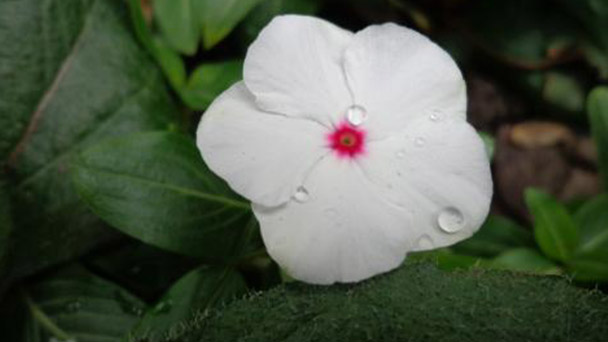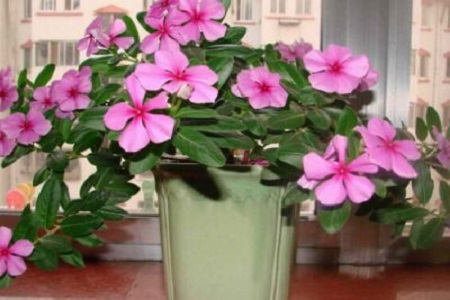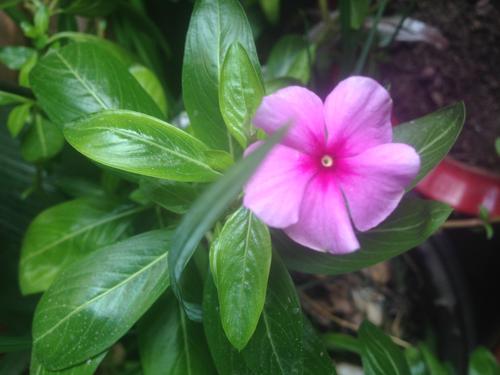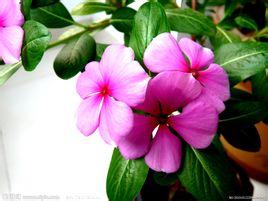Rosy periwinkles profile
Written by Maggie
Sep 07 2021

Rosy Periwinkle, scientific name Catharanthus roseus, is an evergreen erect subshrub of the genus Oleander. Plant height is 30-60 cm, opposite leaves, long elliptic, dark green with luster. Flowers are axillary, corolla saltpeter-shaped, lobes 5, in a wheel-like arrangement, 3 -- 4 cm in diameter, white, pink, or purplish red. Rosy Periwinkle originates from Madagascar, India, existing many horticultural cultivation species.
Rosy Periwinkle Picture

Rosy Periwinkle Morphological Characteristics
Rosy Periwinkle is a perennial herb. Stem is erect, much branched.Opposite leaves, long elliptic, petiole short, entire, smooth glabrous on both sides, the main veins white obvious.
Cymes is terminal. Flowers are rose - red, corolla high - leg butterfly, 5 - lobed, the center of the flower with a dark hole. Rosy Periwinkle height 30 cm -50 cm, long elliptic leaves, dark green with luster. Flowers are axillary, corolla saucer-shaped, five lobes, spreading open, fan leaf arrangement, 3 -4 cm in diameter, white, pink or purplish red.
Rosy Periwinkle Growing Environment
Rosy Periwinkle growth temperature condition
Rosy Periwinkle likes a warm, slightly dry and sunny environment. The growth temperature is 18 ~ 24 ° C from March to July, 13 ~ 18 ° C from September to March of the following year, and the temperature is not less than 10 ° C in winter.
Avoid wet afraid of waterlogging
Rosy Periwinkle is afraid of waterlogging, basin soil watering should not be too much, too wet affect growth and development. Especially indoor winter rosy periwinkle should be strictly controlled watering, with dry as well, otherwise vulnerable to cold. Open cultivation, summer showers, pay attention to timely drainage, lest waterlogging caused by the whole piece of death.
Rosy Periwinkle Main Value
Rosy Periwinkle is a good medicine for cure. The periwinkle flower is not only graceful and has a long flowering period, but also a good medicine for cancer prevention and treatment.
Rosy Periwinkle Propagation
Sowing, cuttings and tissue culture (tissue culture) propagation are commonly used for propagation of Rosy Periwinkle.
Seed propagation of Rosy Periwinkle
Spring sowing in April. Rosy Periwinkle seeds are between 700 and 750 grains per gram, and the suitable temperature for germination is 18 to 24°C. Put a mixture of disinfected leaf rot soil, culture soil and fine sand on a seedling tray, and germinate 14 to 21 days after sowing. After the emergence of seedlings in the light, high temperature at noon, we need to add shading 2 ~ 3 hours. When the seedling of Rosy Periwinkle Is 5 cm tall, there are 3 pairs of true leaves that can be potted.
Cutting propagation of Rosy Periwinkle
Cut off the lower leaves and leave 2-3 pairs of leaves at the top. Insert the soil into the sand bed or leaf rot. Keep the soil slightly moist at the room temperature of 20 ~ 24℃. More about Rosy Periwinkle Propagation.

How to Grow and Care for Rosy Periwinkle
Transplant seedlings of Rosy Periwinkle with 3 pairs of true leaves into 10 cm pots of 3 plants per pot. Seedling height 7 ~ 8 cm, pick the heart 1 time, then pick the heart 2 times, in order to promote more germination branching, more flowering. In the Rosy Periwinkle growing period every half a month fertilizes 1 times, or uses 15-15-30 "Hui Friends" potted flower special fertilizer. Potted or flowerbed off basin, flowering from late May to early November, for more than 5 months. Remove the remaining Rosy Periwinkle at any time during the flowering period to avoid mold affecting plant growth and ornamental value. From August to October for the periwinkles seed collection period, should be picked along with the ripe, so as not to lose seed.
In the Rosy Periwinkle growing season every 30 days or so application of topdressing 1 times, at any time to pay attention to watering, but not water, pay attention to drainage in the rainy season. To promote branching, two or three heart picking sessions should be performed from planting to mid-August so that flowers and leaves can flourish. The overwintering temperature for Rosy Periwinkle is 10-12℃. Sowing Changchun flower, start sowing when the temperature rises to about 10C, transplant once when the seedlings grow 4-5 pairs of true leaves, also can take the tender shoots on the overwintering old plants in spring for cutting.
Rosy Periwinkle Temperature Care
Rosy Periwinkle likes a warm environment, and the temperature is best maintained at 20 to 33 degrees. It should not be too high in summer, and not too low in winter. It should not be below 10 degrees, which may cause Rosy Periwinkle to not grow or go into hibernation.
Rosy Periwinkle Light Care
Rosy Periwinkle likes light while tolerance half shade. Direct light should be given throughout the day in winter.
Rosy Periwinkle Water Care
Rosy Periwinkle like high air humidity, but avoid too much water. In summer water Rosy Periwinkle plant thoroughly every 2 or 3 days, and in winter water every 5 or 7 days, spray 1-2 times every day.
Rosy Periwinkle Soil Care
Rosy Periwinkle can be cultivated in general soil, it is best to use breathable, permeable and fertilizer soil.
Rosy Periwinkle Fertilization Care
Rosy Periwinkle’s flowering and flourishing demand for potash fertilizer, nitrogen fertilizer demand is general. When fertilizing, you can use homemade organic fertilizer or buy the common fertilizer for growing flowers.
Rosy Periwinkle Pest Control
Rosy Periwinkle often has leaf rot, rust and root wart nematode harm.
Leaf rot of Rosy Periwinkle was sprayed with 65% Dexin Zinc WP 500 times liquid. Rust is sprayed with 50% wilting acid wettable powder 2000 times liquid. Root-knot nematodes of Rosy Periwinkle were controlled by spraying 80% dibromochloropropane emulsion 50 times. Or multi-purpose microbial fertilizer prevention and control.

Latest Updated
- Benefits of Bugleweed - 7 Science-backed Health Benefits
- Bugleweed Dangers & Side Effects - Is It Poisonous?
- How to Plant Evergreen Trees - What You Should Know
- When to Plant Evergreens - Grow Guide for Evergreen Trees
- 12 Wonderful Evergreen Shrubs for Your Garden
- 12 Popular Evergreen Plants with Pictures for Beginners
- When And How To Prune A Lilac Bush Like a Pro
- How to Grow & Care for Lilac Vine (Hardenbergia Violacea)
- Japanese Lilac Tree (Syringa Reticulata) Care & Propagation Guide
- Shumard Oak Pros and Cons - What to Know
Popular Articles
- Winter maintenance of Antirrhinum Majus
- How to Grow Terminalia Mantaly Tree
- How to Grow and Care for Crossostephium Chinense
- How to grow Antirrhinum Majus in spring
- Peristeria Elata (Dove Orchid) Profile: Info & Care Guide
- Underwatered Snake Plant (Sansevieria Trifasciata) - Signs And How To Fix
- How to Care for Brazilian Jasmine Plant (Mandevilla Sanderi)
- How to Grow & Care for Graptopetalum Purple Delight in Summer
- Rosa Chinensis (China Rose): Plant Growing & Care Tips
- How to Care for Baby Sun Rose (Aptenia Cordifolia)